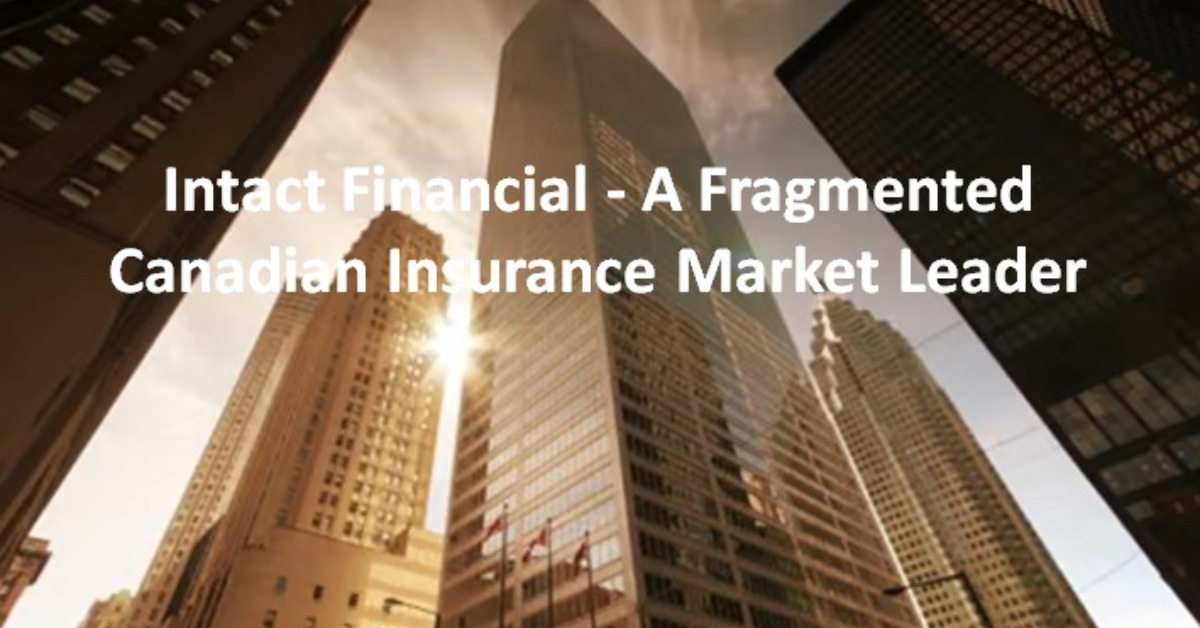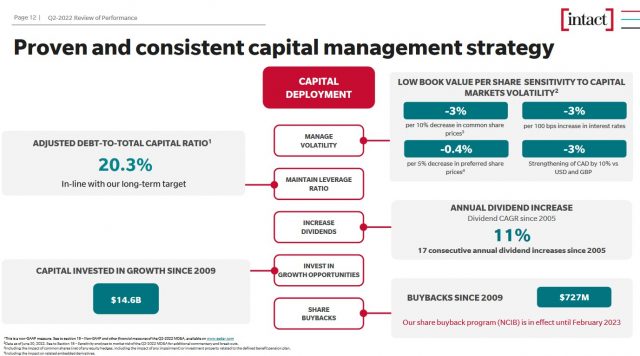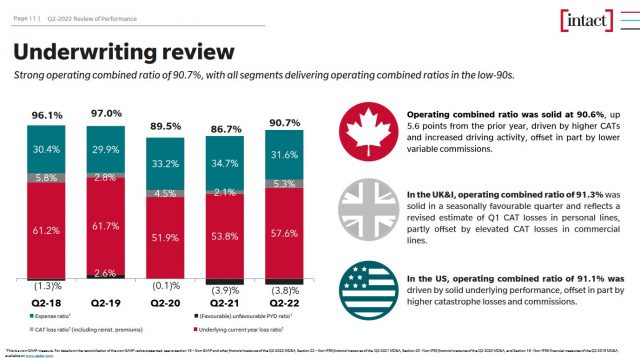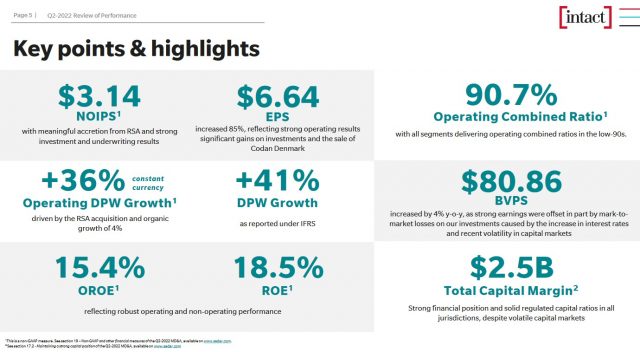Contents

Intact Financial (IFC), a fragmented Canadian insurance market leader, holds a ~20% market share in the property and casualty insurance space; the top 5 hold a ~49% market share.
Not only is IFC a market leader in Canada but it is becoming a specialty solutions leader and following various strategic acquisitions, it now has access to 70% of the global specialty lines market that is estimated to be close to $500B in annual premiums.
Looking at the most recent Investor Presentation, it is difficult not to like IFC's long-term prospects.
I last reviewed Intact Financial Corporation (IFC), Canada's largest provider of property and casualty (P&C) insurance, in my February 10, 2022 post at which time it had just released Q4 and FY2021 results. We now have IFC's Q2 2022 and YTD2022 results which reflect continued strong performance.
As a relatively conservative investor, I am comfortable with IFC's credit risk. My primary interest in conducting this review is to determine if IFC's valuation is acceptable to warrant the purchase of additional shares.
Business Overview
IFC's Annual Information Form provides a good overview of the company. Further information, including the company's history, is found on the company's website and in the FY2021 Annual Report.
Financial Results
Q2 and YTD2022 Results
Please refer to all Q2 and YTD2022 materials which are accessible here.
IFC, like so many other companies, uses several terms and acronyms when reporting its financial results. Fortunately, IFC is kind enough to provide a comprehensive glossary to aid investors in deciphering just exactly what management is coveying.
The following image reflects IFC's capital deployment priorities.

Source: IFC - Q2 2022 Earnings Presentation - July 29, 2022
Looking at page 5 of 24 in IFC's Supplementary Financial Information document, we see that its adjusted debt to total capital ratio increased following the RSA acquisition. IFC communicated it planned to reduce this to 20% within 36 months of closing the acquisition; the acquisition closed on June 1, 2021.
Details of the RSA acquisition are found in Note 4 – Business combination and disposals (starting on page 11 of 41) within the Q2 2022 Interim Consolidated Financial Statements. IFC also raised funds to reduce its debt through a couple of dispositions. Note 4 includes details of these dispositions.
On June 17, 2022, Intact Insurance Specialty Solutions, entered into a definitive agreement to acquire Highland Insurance solutions, the US construction division of Tokio Marine Highland. Closing in the second half of 2022 is subject to regulatory approval and the satisfaction of other closing conditions.
Highland is a managing general agent specializing in the builder’s risk segment of the construction industry; this acquisition will expand IFC's portfolio of owned distribution assets.
Underwriting Ratios
The Operating Combined Ratio (OCR), consists of 2 components:
- claims ratio
- expense ratio
The OCR is typically expressed as a percentage. It is a measure of profitability used by an insurance company to gauge how well it is performing in its daily operations. Many insurance companies believe that the combined ratio is the best way to measure success because it does not include investment income. It only includes profit earned through efficient management. This ratio is calculated by taking the sum of incurred losses and expenses and then dividing them by the earned premium.
A ratio below 100% indicates the company is making an underwriting profit whereas a ratio above 100% means the company is paying out more money in claims than it is receiving from premiums.
IFC's OCR in FY2017 - FY2021 is 94.3%, 95.1%, 95.4%, 89.1%, and 88.8%. Its OCR was 91.3% in Q3 2021, 87.8% in Q4 2021, 91.7% in Q1 2022, and 90.7% in Q2 2022.

Source: IFC - Q2 2022 Earnings Presentation - July 29, 2022
In a nutshell, IFC's OCR is consistently below 100%!
Capital Structure
IFC has a proven and consistent capital management strategy. Its target capital structure is:
- 70% equity;
- 20% debt excluding hybrid debt; and
- 10% preferred shares and hybrid debt.
Further details are found in section 17.3 (Managing Leverage) on page 38 of 68 in Management’s Discussion and Analysis for Q2 2022.
IFC classifies hybrids with preferred shares since they are convertible to preferred shares pari passu to its existing preferred shares in case of default or bankruptcy and include an interest payment deferral option, whereby payments can be delayed for a period of up to 5 consecutive years.
At the end of Q2 2022 (FY2021 percentages are in brackets), IFC's capital structure consisted of:
- 71% equity (~67%);
- 20% debt excluding hybrid debt (~23%); and
- 9% preferred shares and hybrid debt (~10%).
Looking at IFC's senior and subordinated debt we see the maturity dates are well staggered.
Maintaining a strong capital position is a key priority. Looking at the capital ratios at the end of Q2 2022 we see that IFC's levels are well above its Company action levels (CALs). The CALs are thresholds below which regulator notification is required together with a company action plan to restore capital levels. The average CAL for all regulated Canadian insurance entities is 168% MCT. The CAT varies by legal Canadian entities. The CAL is 200% RBC for regulated insurance entities in the US and 120% SCR for those in the UK & Ireland.
- MCT - Minimum capital test (Canada)
- SCR - Solvency Capital Requirement (Europe)
- RBC - Risk-based capital (US)
Credit Ratings
IFC's credit ratings are accessible here. There is no change in the ratings after my previous review.
While we see multiple ratings, I focus on the senior unsecured debt ratings assigned to Intact Financial Corporation because this is the publicly-traded company in which I hold shares.
The assigned ratings differ slightly but all are investment grade.
- DBRS's rating is the middle tier of the upper-medium grade investment-grade category.
- A. M. Best's and Fitch's rating is the bottom tier of the upper-medium grade investment-grade category.
- Moody's rating is the top tier of the lower-medium grade investment-grade category.
DBRS, A. M. Best, and Fitch define IFC as having a STRONG capacity to meet its financial commitments. Moody's rating defines IFC as having an ADEQUATE capacity to meet its financial commitments.
Despite the slight variance in ratings, all ratings are acceptable for my conservative nature.
Dividend and Dividend Yield
IFC has increased its dividend for 17 consecutive years.
The 3rd $1.00/share quarterly dividend distribution is scheduled for September 30, 2022. Based on the current $190.60 share price, the dividend yield is ~2.1%. When I wrote my prior review in February, IFC had announced an increase in its quarterly dividend from $0.91/share to $1.00/share. With shares trading at ~$185, the forward dividend yield was ~2.16%.
IFC's weighted-average number of common shares outstanding in FY2011 - FY2021 (in millions) is 115, 131, 132, 132, 132, 131, 133.1, 139.2, 139.5, 143, and 162.4.
In Q2 2022, the weighted-average number of common shares outstanding was ~175.5. Following this date, 138,850 common shares were repurchased and cancelled under the normal course issuer bid.
IFC suspended share repurchases during FY2020 and FY2021. On February 17, 2022, however, IFC commenced a normal course issuer bid (NCIB) program to repurchase for cancellation, up to 5,282,458 common shares until February 15, 2023. This represents ~3% of the issued and outstanding shares as of February 8, 2022.
From February 17, 2022 to June 30, 2022, a total of 556,440 common shares were repurchased under the NCIB program at an average price of $179/share for a total consideration of ~$0.1B.
Valuation
IFC's PE in FY2011 - FY2020 is 15.86, 14.96, 18.50, 16.64, 16.86, 23.10, 19.41, 20.97, 27.43, and 24.00.
When I analyzed IFC's FY2021 results, it had generated $12.40 in diluted EPS and the share price at the time was ~$185 thus giving us a diluted PE of ~15.
I purchased shares at $165.82 on November 8, 2021. By the time I wrote my November 11 post, the share price had risen to $170. Using the forward adjusted diluted EPS guidance from the brokers which cover IFC and my purchase price, the forward adjusted diluted PE levels were:
- FY2021 - 14 brokers - mean of $10.78 and low/high of $9.45 - $11.95. The forward adjusted diluted PE was ~15.4.
- FY2022 - 14 brokers - mean of $10.98 and low/high of $9.48 - $12.23. The forward adjusted diluted PE is ~15.1.
- FY2023 - 9 brokers - mean of $12.28 and low/high of $10.21 - $13.03. The forward adjusted diluted PE is ~13.5.
I did not record the guidance from the brokers when I acquired additional shares at $162.59 on January 10, 2022. I imagine the guidance was not that much different from early November so the forward adjusted diluted PE levels were probably fairly similar.
When I reviewed IFC on February 10, 2022, shares were trading at ~$185. Using the forward adjusted diluted EPS estimates reflected on the 2 online brokerage platforms I use, IFC's valuation was:
- FY2022 - 13 brokers - mean of $11.27 and low/high of $10.33 - $12.11. The forward adjusted diluted PE is ~16.4.
- FY2023 - 13 brokers - mean of $12.28 and low/high of $10.53 - $13.33. The forward adjusted diluted PE is ~15.
Only 1 broker had provided an estimate for 2024; this estimate was $12.85.
Shares are now trading at $190.60.Using current broker estimates, IFC's forward adjusted diluted PE levels are:
- FY2022 - 15 brokers - mean of $11.71 and low/high of $11.15 - $12.50. The forward adjusted diluted PE was ~16.3.
- FY2023 - 15 brokers - mean of $12.87 and low/high of $11.03 - $13.81. The forward adjusted diluted PE is ~14.8.
- FY2024 - 6 brokers - mean of $13.86 and low/high of $12.06 - $15.41. The forward adjusted diluted PE is ~13.8.
Despite the runup in IFC's share price after my prior reviews, its valuation based on forward adjusted earning estimates is still reasonable.
Final Thoughts
I initiated a 300-share position @ $53.66/share on January 18, 2007 through a Registered Education Savings Plan (RESP) account for our daughter. At the time, IFC was called ING Direct.
In 2019, 2020, and 2021, I had to liquidate these shares given the terms and conditions of the RESP. Nevertheless, I replaced these shares with IFC shares in other accounts so I have essentially been a shareholder for ~15 years.
IFC was my 30th largest holding when I completed my Mid 2022 Investment Holdings Review and my 26th largest holding when I completed my Investment Holdings Review on January 7, 2022. It was not a top 30 holding when I completed my mid-April 2021 and mid-August 2020 reviews.
IFC's current valuation based on broker estimates is comparable to when I previously acquired shares. I consider IFC's valuation to be fair and the plan is to add to my current exposure over time.
I wish you much success on your journey to financial freedom!
Note: Please send any feedback, corrections, or questions to [email protected].
Disclosure: I am long IFC.
Disclaimer: I do not know your circumstances and do not provide individualized advice or recommendations. I encourage you to make investment decisions by conducting your own research and due diligence. Consult your financial advisor about your specific situation.
I wrote this article myself and it expresses my own opinions. I do not receive compensation for it and have no business relationship with any company mentioned in this article.



